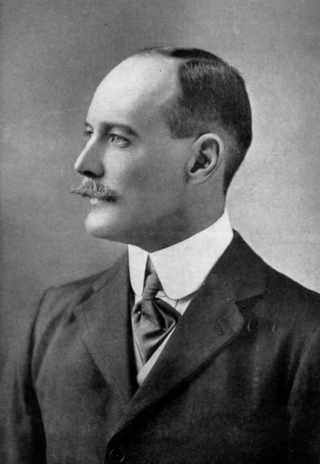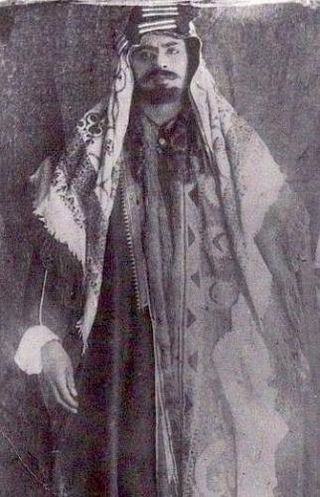Related Research Articles

Abdulaziz bin Abdul Rahman Al Saud, known in the West as Ibn Saud, was an Arab political and religious leader who founded Saudi Arabia – the third Saudi state – and reigned as its first king from 23 September 1932 until his death in 1953. He had ruled parts of the kingdom since 1902, having previously been Emir, Sultan, and King of Nejd, and King of Hejaz.

Abdul Rahman bin Faisal Al Saud was the last emir of Nejd, reigning from 1875 to 1876 and from 1889 to 1891. He was the youngest son of Emir Faisal bin Turki bin Abdullah and the father of Abdulaziz, the founder of the Kingdom of Saudi Arabia.
Abdulaziz bin Muhammad Al Saud was the second ruler of the Emirate of Diriyah. He was the eldest son of Muhammad bin Saud and the son-in-law of Muhammad bin Abdul Wahhab. Abdulaziz ruled the Emirate from 1765 until 1803. He was nicknamed by his people as the savior of his time due to his fearless activities.
Saud bin Abdulaziz Al Saud ruled the First Saudi State from 1803 to 1814. Saud annexed Mecca and Medina from the Ottoman Empire making him the first Al Saud ruler who received the title of the servant of the Two Holy Cities. During his rule the state experienced a significant level of strength and expansion for which he was called Saud Al Kabeer or Saud the Great.

ʿAsir is a Minṭaqah in the southwest of Saudi Arabia, which is named after the ʿAsīr tribe. It has an area of 76,693 square kilometres (29,611 sq mi), and an estimated population of 2,211,875. 'Asir is surrounded by Mecca Province to the north and west, Al-Bahah Province to the northwest, Riyadh Province to the northeast, Najran Province to the southeast, and Jazan Province and the Yemeni Muhafazah (Governorate of Sa'dah to the south.

Najran, is a city in southwestern Saudi Arabia near the border with Yemen. It is the capital of Najran Province. Designated as a new town, Najran is one of the fastest-growing cities in the kingdom; its population has risen from 47,500 in 1974 and 90,983 in 1992 to 246,880 in 2004 and 505,652 in 2017. The population mostly originates from the ancient tribes of Yām, Mákram, and Hamdan.

Saud Al Kabeer bin Abdulaziz Al Saud was a grandson of Saud bin Faisal bin Turki and a distant nephew and important supporter of King Abdulaziz, founder of Saudi Arabia. Prince Saud was one of the most known Najdi people. Through his marriages he was the brother-in-law, and later he became the son-in-law, of King Abdulaziz. Saud was married for 45 years to King Abdulaziz's eldest sister Noura bint Abdul Rahman, and after her death in 1950 he married the King's daughter Princess Hessa.

Sa'ad bin Abdul Rahman Al Saud (1890–1915) was the brother of Abdulaziz, Emir of Nejd. He was one of Abdulaziz's most devoted supporters and a key lieutenant in his early military campaigns.

Captain William Henry Irvine Shakespear, CIE, was a British civil servant and explorer who mapped uncharted areas of Northern Arabia and made the first official British contact with Ibn Sa'ud, future king of Saudi Arabia. He was the military adviser to Ibn Sa'ud from 1910 to 1915, when he was shot and killed in the Battle of Jarrab by Ibn Shraim. He was buried in Kuwait.

The Unification of Saudi Arabia was a military and political campaign in which the various tribes, sheikhdoms, city-states, emirates, and kingdoms of most of the central Arabian Peninsula were conquered by the House of Saud, or Al Saud. Unification started in 1902 and continued until 1932, when the Kingdom of Saudi Arabia was proclaimed under the leadership of Abdulaziz, known in the West as Ibn Saud, creating what is sometimes referred to as the Third Saudi State, to differentiate it from the Emirate of Diriyah, the First Saudi State and the Emirate of Nejd, the Second Saudi State, also House of Saud states.

Abdulaziz bin Mutaib Al Rashid, better known as Ibn Rashid, was the Emir of Jabal Shammar from 1897 to 1906.
Sultan bin Bajad bin Humaid al-'Utaybi was the Sheikh of the Otaibah tribe and one of the prominent leaders of the Ikhwan movement in the Arabian Peninsula. This tribal army supported King Abdulaziz in his efforts to unify Saudi Arabia between 1910 and 1927.
The Battle of Sabilla was the main battle of the Ikhwan Revolt in northern Arabia between the rebellious Ikhwan forces and the army of Abdulaziz al-Saud. It is the last tribal uprising in Arabia. It was also the last major battle in which one side rode camels, as the Ikhwan emphasized radical conservatism and shunned technological modernization.

The Ikhwan revolt was an uprising in the Arabian Peninsula from 1927 to 1930 led by the Ikhwan. It began in 1927, when the tribesmen of the Otaibah, Mutayr and Ajman rebelled against the authority of Ibn Saud and engaged in cross-border raids into parts of Transjordan, Mandatory Iraq and the Sheikhdom of Kuwait. The relationship between the House of Saud and the Ikhwan deteriorated into an open bloody feud in December 1928. The main instigators of the rebellion were defeated in the Battle of Sabilla, on 29 March 1929. Ikhwan tribesmen and troops loyal to Abdulaziz clashed again in the Jabal Shammar region in August 1929, and Ikhwan tribesmen attacked the Awazim tribe on 5 October 1929. Faisal Al Dawish, the main leader of the rebellion and the Mutair tribe, fled to Kuwait in October 1929 before being detained by the British and handed over to Ibn Saud. Faisal Al-Dawish would die in Riyadh on 3 October 1931 from what appears to have been a heart condition. Government troops had finally suppressed the rebellion on 10 January 1930, when other Ikhwan rebel leaders surrendered to the British. In the aftermath, the Ikhwan leadership was slain, and the remains were eventually incorporated into regular Saudi units. Sultan bin Bajad, one of the three main Ikhwan leaders, was killed in 1931, while Al Dawish died in prison in Riyadh on 3 October 1931.
The Taif massacre was an incident that followed the short 1924 Battle of Taif; the entire episode is also known as the al-Taif incident. The battle and resultant massacre comprised the first major standoff of the Second Hashemite-Saudi War. Following a short siege, the city was abandoned by Hashemite forces and then capitulated to the battle-ready Ikhwan force under the command of Abdulaziz Ibn Saud. The Ikhwan troops took out their rage on the residents of the city. In the resulting bloodbath, some 300-400 Ta'if residents were massacred.
The Conquest of al-Hasa was achieved by the Saudi forces of ibn Saud with support from the Ikhwan in April 1913. The Oasis of al-Hasa was conquered from an Ottoman garrison, who had controlled the area since 1871.
Early in the year 1931, the Kingdom of Hejaz and Nejd, ruled by the House of Saud, engaged in an ill-documented border skirmish against the Mutawakkilite Kingdom of Yemen.
The Battle of Kanzan was a territorial battle between the Al Saud and their long-term enemies, the Ajman tribe, which began in June 1915 and lasted for nearly six months. The reason for the battle was the disloyalty of the tribe to the Al Saud rule.

Dhaydan bin Hithlain was one of the leaders of the Ajman tribe and Amir of the hijrah (settlement) of Al Sarrar. His full name was Dhaydan bin Khalid bin Hizam bin Hithlain. Alexei Vassiliev also calls him Zaidan.

The Declaration of theUnification of Saudi Arabia was officially announced by Prince Faisal bin Abdulaziz, the Viceroy of Hejaz on behalf of King Abdulaziz ibn Saud on September 23, 1932, at 9:00 am from al-Hamidiyah Palace in Mecca. Faisal read out the Royal Decree No. 2716 issued by Abdulaziz ibn Saud on September 18, 1932, that renamed the Kingdom of Hejaz and Nejd and its annexes as the Kingdom of Saudi Arabia.
References
- ↑ Philby, Harry St John Bridger (1955). Saʻudi Arabia. Benn. p. 322.
- ↑ Safran, Nadav (1988). Saudi Arabia: The Ceaseless Quest for Security. Cornell University Press. p. 54. ISBN 9780801494840.
- 1 2 3 Gibler, Dougla; Miller, Steven; Little, Erin (2017). "Report on MIDs that could not be found" (PDF). dmgibler.people.ua.edu. Retrieved 6 September 2019.